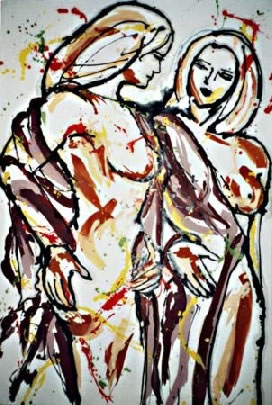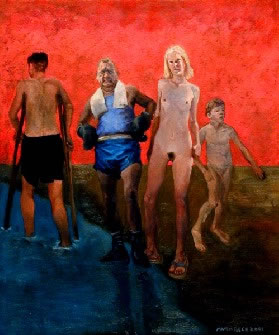It Takes a Neighborhood
John Haberin New York City
Entelechs and Allies: Art on the Web
People have been talking about the global village since well before the Web. Perhaps they should look instead to the global neighborhood.
I want to write about a real global connection, an innovative assembly recently on the Web called Entelechs and Allies. (One can meet its contributors through another artist Web site, Artlives.) Its unusual name goes back to classical Greece, and conversely its place and purpose in art would have made little sense just a handful of years ago.  One can see the change simply in the range of artists involved.
One can see the change simply in the range of artists involved.
Urban organisms
From Eastern Europe, Adam Sofineti and Alex Berdysheff look back to Surrealism in the inward turn of their imagery and in its debts both to realism and to abstraction. Kieu Giang finds respite from the political urgency of life at home, in the Vietnamese artist's delightfully lush abstraction. Erato Tsouvala, from Greece, reminds me at once of American representational art at mid-century and Germany's postmodern reworking of it decades later. In His Touch, a long line weaves together dynamic, rather sexy figures with the white field showing through. Martin Beck, here in the proverbial First World, knows the culture wars well. He represents people at the edge of city and suburbia—increasingly, as in The Boxers, represented in a more disorienting physical, psychological, and painterly space.
Yet to understand this show's growth—and the sense that it gives to the whole idea of growing—let me step back for a moment from the selection. Think back first to the far narrower limits of the mid-twentieth century.
In those cozy old days, give or take wars and cold-water flats, my own home town was rediscovering Modernism and abstraction. And yet for decades artists had moved to the city and tapped its pulse. Legend has it that they found each other in two quintessential urban environments—in schools and in bars, but one should add, too, a world right out of the age's great photographs. They evoke the glamour and despair then of group shows, studio visits, and the tumult of great cities.
Douglas Crimp has called Modernism a creation of yet another urban phenomenon, the museum. And sure, museums were just then creating modern art's sense of history, with dealers and curators the heroes nearly as much as artists. Still, even presuming that one can start a history of modern art so late, with the birth of the Museum of Modern Art, Alfred Barr and Peggy Guggenheim do not deserve all the credit. Artists were struggling themselves to find a sense of community away from the public eye and beneath the public's scorn.
Museums resemble impersonal institutions and personal empires, with the power to demand to be looked at. Something else again makes those assemblies of artists so remarkable to this day. Like any urban landscape, artists stayed so intimate and yet so contentious, so allied in their sense of purpose and so chaotic in how they assembled. I would not have looked forward to criticism from Hans Hofmann. I would not have wished to face half the arguments over the Sublime at the Cedar Bar. I would not have stood up to the look from Jackson Pollock when Less Krasner, a woman alone, knocked on his studio door.
Then, too, the city drew immigrants and the children of displacement, even as it flaunted a clumsy nation's sense of itself as a young, self-involved empire. America already carried a big stick, like a spoiled child. Within, however, it held a sly mix of city kids, western drifters, and European stowaways. These men and women did what they could with a rather smaller stick, the kind with a little horsehair at the end.
Empires and entelechies
In other words, the art world was a kind of urban organism. And, much like any organism, it had to deal with chance and the sometimes conflicting demands of an overpowering head and heart. Villages—global, historical, or mythical—are not like that. Once they are founded, consciously and with determination, they tend to stay put, with all too many exclusions in place, too. Town squares get used mostly for parades and other rituals anyhow.
Cities hardly serve their old roles these days, and America has no business then or, especially, now claiming to stand for them. Moreover, the Internet has upped the ante. Global empires throw more money around than ever. They take urban, suburban, and rural life alike as fodder for the corporate blender. They make mine and art history's tale of a single nation no more than a preamble.
Crimp spoke of the "ruins of the museum," but again he assigns far too much credit, this time to Postmodernism for its supposedly destructive virtue. Last I looked, museums still get to play muse or at least to fight for it. They have spread to suburbs, preserving and elevating every kind of commercial culture, beyond Modernism's wildest imaginings. They have spawned power plays and gift shops, and postmodern art keeps trying to mimic them. The Web, however, may well feed off and propagate telecommunications empires, but at least for the moment, it also takes its own course. Unlike most museum exhibitions, when it goes down, people still get upset.
Like my older model, this arena is a rather contentious one, and one cannot even begin to see its potential in the Whitney's awkward show of Internet art. Chat rooms and bulletin boards bring people together at the cost of sometimes lively, more often leaden and angry words. My second favorite online forum ever dissolved in months. Over what? I can no longer remember, actually, but it seemed important at the time.
My favorite forum began as refugees expelled from, if not just fleeing, still another news group. This one, called Artlives, does have a vision, for it has seen the organic nature of their meeting. It calls the outcome Entelechs and Allies. As the curator has explained better than I, the title entelechs is quite old-fashioned for such a new-fangled medium. Alison Raimes, an abstract painter herself, does not exhibit in this particular group exhibition, but she surely takes the idea from what has long driven her own work.
Raimes adopts the word from entelechy, a decidedly pre-modernist conception of the body. The Greek word denotes an Aristotelian sense of an organism's chance development as both natural and purposive. I am not so sure. I was trained in theoretical physics, after all, and my body is falling apart as fast as my computer, no matter how much I jog. Aristotle would have had trouble, too, with a show so able to represent women. Besides, like gender differences, "natural" has a nasty way of disguising ideologies.
Cell division
And yet the metaphor still rings true. It reminds me of the thousands of internal linkages between reviews online, including on my own Web site. Far more important, it shows the potential one is seeing today—for a new kind of exhibition space, in a new kind of neighborhood. Entelechs and Allies is already there, now. It starts online, draws from all over the world, and heads after a full year of development and free but properly argumentative exchange for a more traditional exhibition space, in London in July 2002. In all these ways, and more, it is fulfilling the metaphor of organic, purposive development. 
Its meeting-place may seem all too common in a postmodern, connected society, but this group, more even than most Internet neighborhoods, can fairly claim to have no peer. That, I think, is part of its value. In a powerful, commercial, backward-looking art world, the Internet stands mostly for e-commerce. No wonder museums have huge Web sites, to attract blockbuster crowds, while few galleries and artists yet bother with the Web, for fear they will give their work away.
The group still shows that other side of the global urban center, deep divisions. I admire that it has taken on so many media, mediums, and forms, sometimes already digital, sometimes luscious old abstract oils, not to mention art from at least three continents. No other venture I know is even informing me about art in nearly so many places. It reflects international divisions as well. Now the worlds of art sit side by side, often disconcertingly so. If the mid-century communities had a strong influx from Eastern Europe, opening art to the excluded and colonized, today's juxtapositions must extend to gender and the Third World.
I do not like all the artists in this show thus far—not half as much as the gorgeous site design itself. Shan Wells, also a contributing artist, works beautifully in shades of gray, barely hinting at the Flash-driven sophistication. In contrast, some art on display seems to me a bit itself wrapped up in early modern vocabulary. That is the nature of a group show, though, particularly one subtitled "intercultural disturbance and resonance," Raimes herself speaks wisely of "multiple modernities," in a world for which "multiculturalism has become a marketing ploy and a political pawn." An exhibition can raise questions, not answer them with finality, and the show itself—both the selection and each artist's works, not to mention my understanding of them—will evolve and grow by its very nature.
What with too much of the world trying to catch up to American commerce and connection speeds, the exhibition must reflect the divisions, growth, and puzzles of the World Wide Web. With luck, it can do so knowingly and productively, and I believe it does, just as it choses London rather than New York for its future exhibition. For that matter, the same divisions and hopes must color this very essay, published solely online itself and yet another child of productive dissension. I contributed a draft to the group, only to find that little remained. And so now, paradoxically, I am reviewing skeptically and yet fervently a show to which I contributed.
When I turned to what survived of my first thoughts on the group's original Web site, they had gained in clarity and relevance from the editing. In any case, I smiled. This is like the Cedar Bar after all. Or then again, perhaps it simply reflects my stance as part of an entelechy, neighborhood, or multiplicity of Modernisms—divided myself and growing.

"Entelechs and Allies," curated by Alison Raimes and an outgrowth of the news group ArtLives, hoped to evolve throughout 2001 and into 2002, when it planned to culminate in a CD-ROM and (physical) exhibition at the Nunnery Gallery, Bow Art Trust. Since then, setbacks have come all too readily. If its metaphor makes any sense, however, it will continue to evolve, naturally or otherwise, after all else is said and done.




